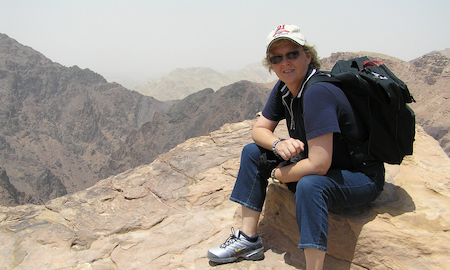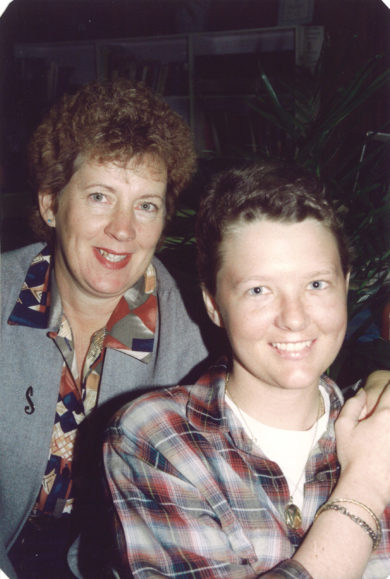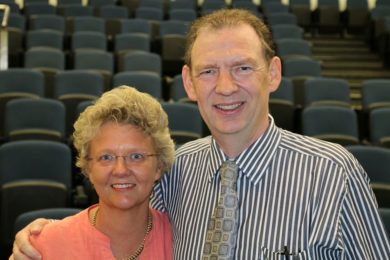A bone marrow transplant saved Judi’s life after a shock diagnosis
Back in 1993, the only person who could save Judi Haidley’s life was her second cousin, Sandra Veitch, who gave Judi, now 48, a second chance at life.
“My story began at 20 years of age. I was enjoying the simple pleasures in life, employed at the Warwick Daily News, playing sport, good friends and a great family,” said Judi.

Then, Judi found herself experiencing extreme and unexplained fatigue.
“I would come home for lunch and lie on the lounge, exhausted,” explained Judi.
“Mum said I looked very pale, suggesting I could be anaemic and should have a blood test.”
Judi put her symptoms down to playing too much sport and not getting enough sleep but eventually she had to go to the doctor with “terrible stomach cramps”.
Her doctor, thinking it may be endometriosis, gave Judi a blood test form and advised she have the tests after Christmas. It was December 23, 1991 but Judi decided to have the tests right away and she certainly wasn’t expecting bad news.
“How wrong I was,” said Judi, who got a message at work the next day that her mother was on her way to pick her up, to take her to the doctor.
“I still didn’t think anything could be wrong with me. I thought something had happened to my dad or brother,” she said.
Judi will never forget the moment the doctor called them both into the surgery, sat them down, and said, “there’s no easy way to tell you, Judi… you have a serious illness, leukaemia”.
“There was silence. My thoughts were of total disbelief,” said Judi.
“I knew it was serious, but what did this mean? What was going to happen, why did I have it, how did I get it? All these questions swamped me.
“We gathered as a family and went straight to Brisbane for treatment,” said Judi, who spent Christmas in hospital. Her diagnosis was chronic myeloid leukaemia (CML).
The following months were a whirlwind of “weekly blood tests, fortnightly visits to Brisbane, changes in medication to slow progress of the CML and make it easier to return to a normal way of life”.
“My white blood cells had failed to mature properly. Their normal range is 4000-11,000 but mine had multiplied to 250,000 and had overpowered the normal cells in the bloodstream.”
Judi was told by her doctor in Brisbane that a bone marrow transplant would be the best treatment for her, and her family would be checked as possible bone marrow donors.
“From day one, Mum asked questions, researched and sent money to the Red Cross to search overseas to find me a donor.”
In September 1992, Judi was to celebrate her 21st birthday but the party her brother, Cameron, and his wife, Lyndal were organising had to be postponed three times. She was admitted to hospital as there was concern her CML had progressed to the acute stage, but thankfully, she had glandular fever.
It was in mid-1993 that the Royal Brisbane Hospital transplant doctor, Dr Simon Durrant decided on the most suitable donor for Judi, and it turned out to be her second cousin, Sandra, who had already been listed on the Australian Bone Marrow Registry.

“Sandra was not fully compatible but was the closest match and the only person in the whole world who could save my life,” said Judi.
Sandra took time off from work to have her bone marrow harvested from her hip and breast bones, and she travelled from Warwick to Brisbane to donate platelets “which I believe was a huge boost in my recovery” said Judi.
“She never even hesitated and every time I see her, I say ‘thank-you’!”
The date was set for the transplant – September 30 – and Judi went into hospital on September 21 – the day after her birthday, which she shares with her mum.
Judi’s parents, Don and Heather drove her to hospital to have a Hickman line inserted, and as her mum was staying on in Brisbane there was concern about where she would stay.
“When the Leukaemia Foundation rang and said a one-bedroom unit was available at Herston, close to the hospital, it was wonderful news,” said Judi.
“It meant Mum had people around her who were in the same position and understood what she was going through, and I knew she was safe. That was a great comfort for me.”
During the bone marrow transplant, Judi spent five weeks in an isolation room.
“The only visitors allowed in the room were my family,” said Judi.
“My nephew, Heath, who was two, had to talk to me through the glass door in case of infection.
“I had chemotherapy and full-body radiation and during the following weeks, I had everything from a burst blood vessel in my eye to all the side-effects including vomiting, diarrhoea, fluid on the lungs, jaundice, mouth ulcers, hair loss and a chest infection.
Judi also developed graft-versus-host disease – an unpleasant rash all over her body which “was terribly itchy” and reduced her to tears at times.
“I had no sense of smell or taste and didn’t feel like eating until Mum made me some spaghetti. From then on Mum made my dinner each night.”
Judi spoke highly of the dedicated work, care and knowledge that the doctors, nurses and staff at the hospital provided to patients who were “going through one of the most frightening times of their lives”.

Eventually, Judi was released from her isolation room and admitted to the outer wards. And later, she was allowed to stay with her mother at Herston, and she made daily visits to the hospital.
Judi was anxious the day they left Herston which had been “home” for five months and her security. Home in Warwick was two hours away in case of any emergency.
The following year Judi also stayed at the Leukaemia Foundation’s ESA Village and over the years she has had hospital stays, including another Christmas, in 1994.
“There are no wise words to tell a person how to cope with cancer. A positive attitude, a will to live, a supportive family, trust in the doctors and nursing staff, and the support from the Leukaemia Foundation,” she said.
“The Foundation offers so much support to patients and their families during times of great illness and great uncertainty.”
Judi’s overall outlook is one of optimism and gratitude.
“Family is very important to me and I have a wonderful group of friends,” said Judi, who still lives at Warwick where she works full-time, plays tennis and enjoys photography.
“I have a love of owning British cars including an MGB, Mini K, Mini LS and a Mini Moke.
“And I have travelled all over Australia and have visited many countries overseas,” said Judi whose extensive travels have included the UK, Ireland and Europe, Turkey, Jordan, Borneo and Canada.
“Sadly, I was unable to have children of my own, but I have three nephews who I gave a lot of my time during their childhood years.
“Now they are all grown up with families of their own. They help me with the cars when they have time and still call me Aunty Judi,” she said.
“I still have yearly check-ups. This gives me a peace of mind that all is okay. I still get concerned with my health if something isn’t quite right and I know my limitations.
“Today, I take one day at a time and look forward to the days ahead,” said Judi.
Last updated on January 5th, 2023
Developed by the Leukaemia Foundation in consultation with people living with a blood cancer, Leukaemia Foundation support staff, haematology nursing staff and/or Australian clinical haematologists. This content is provided for information purposes only and we urge you to always seek advice from a registered health care professional for diagnosis, treatment and answers to your medical questions, including the suitability of a particular therapy, service, product or treatment in your circumstances. The Leukaemia Foundation shall not bear any liability for any person relying on the materials contained on this website.